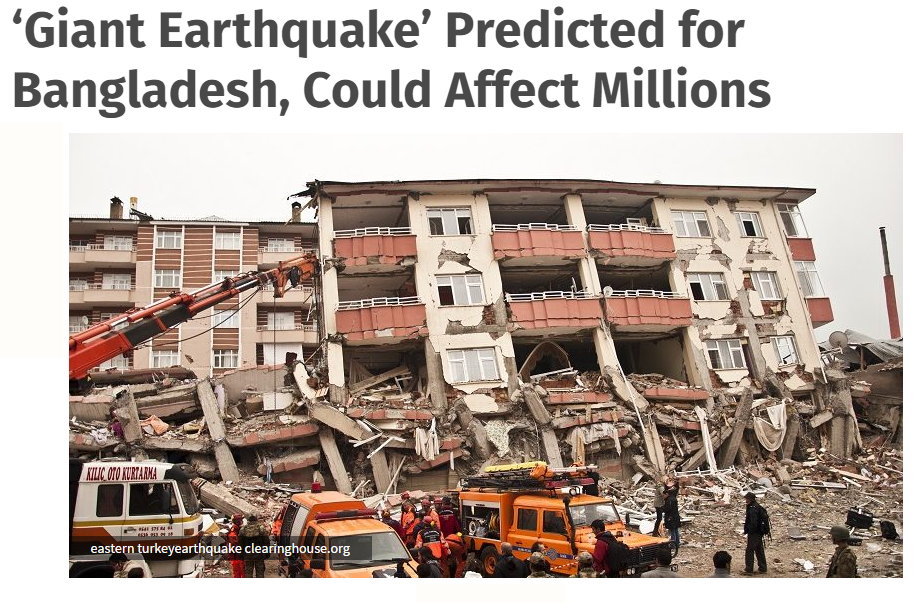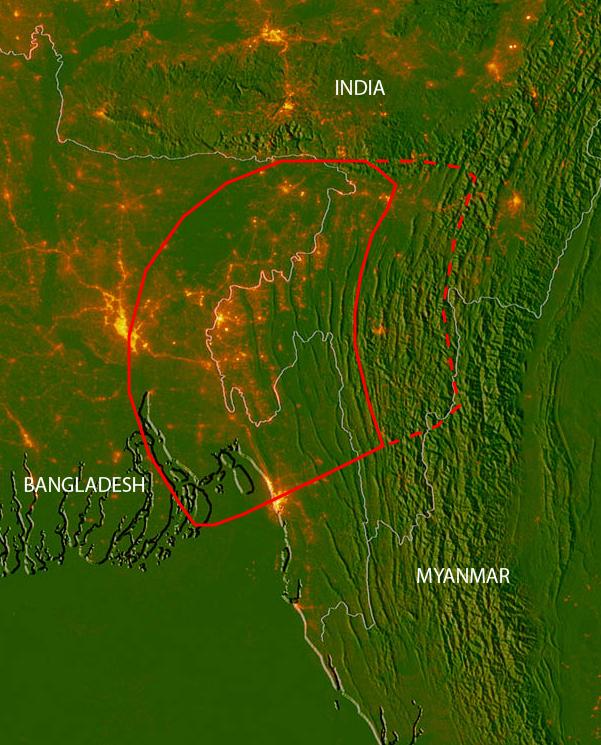A giant mega-quake lurking under Bangladesh and beyond
A huge earthquake is rapidly building beneath the impoverished nation called Bangladesh – which is also the most densely populated nation on earth. Mud that has accumulated some 12 miles (19 km) deep in the delta of the Ganges and Brahmaputra rivers could shake like gelatin, and liquefy in many places, sucking in buildings, roads and people. Scientists have stated that they have new evidence of increasing strain there, where two tectonic plates underlie the world’s largest river delta. They estimate that at least 140 million people in the region could be affected when the boundary ruptures – the destruction could come not only from the direct results of constant vigorous shaking, but changes in the courses of great rivers, and in the level of land already perilously close to sea level.
In the event of a megathrust earthquake along this fault line, there will be thousands of immediate deaths, and millions will be displaced around a nation with newly fragmented infrastructure already beset by poor management. In a worse-case scenario, it will cause an unprecedented humanitarian disaster.
Subduction-zone quakes generally occur where plates of heavy ocean crust slowly dive offshore beneath the lighter rocks of adjoining continents, or under other parts of the seafloor. Sometimes sections get stuck against each other over years or centuries, and then finally slip, moving the earth. Scientists knew of the plate boundary in and around Bangladesh, but many assumed it to be sliding only horizontally near the surface, where it sometimes causes fairly large, but less damaging earthquakes in areas that are not as densely populated. However, the authors of the new research say movements on the surface over the past decade show that subduction is taking place below, and that part of the plate juncture is locked and loading up with stress.

There is a giant earthquake building beneath Bangladesh, according to an international team of researchers. Although they do not know when the disaster will occur, the team believes that 140 million people in this region could be affected once it strikes.
Strain between the plates has been building for the last 400 years — the span of reliable historical records, which lack reports of any mega-quake. When an inevitable release comes, the shaking is likely to be larger than 8.2, and could reach a magnitude of 9 (mega-quake), similar to the largest known modern quakes!
Bangladesh, India’s neighbor, lies on the far eastern edge of this plate, but pressure from the collision seems to be warping Asia clockwise around the top of Bangladesh, ending up largely in the next country over, Myanmar. This wraparound arrangement has resulted in a crazy quilt of faults and quakes in and around Bangladesh. There have been dozens of large quakes in between, but the assumption was that no actual subduction was taking place under Bangladesh itself, seeming to insulate the region from a truly gigantic one. The new study undercuts this idea.

Susan Hough, a U.S. Geological Survey seismologist who also studies the region and was not involved in the study, said that in recent years, “we’ve been surprised by big earthquakes that have not been witnessed during historical times, or witnessed so long ago, they were forgotten. Studies like this are critical for identifying those zones.”
Bangladesh is a nation that is pummeled by natural disasters of all kinds, including landslides, floods, tropical cyclones and of course earthquakes. The world’s eighth-most populous nation, it is beset by corruption, poverty, governmental inaction, climate change, human rights abuse, and overpopulation.
Syed Humayun Akhter, a geologist at Dhaka University says that fast-growing, poor Bangladesh is unprepared; no building codes existed before 1993, and even now, shoddy new construction flouts regulations. Past quake damages and deaths are no indicator of what could happen now, he said; population and infrastructure have grown so fast that even fairly moderate events like those of past centuries could be mega-disasters. “Bangladesh is overpopulated everywhere,” he said. “All the natural gas fields, heavy industries and electric power plants are located close to potential earthquakes, and they are likely to be destroyed. In Dhaka, the catastrophic picture will be beyond our imagination, and could even lead to abandonment of the city.”
